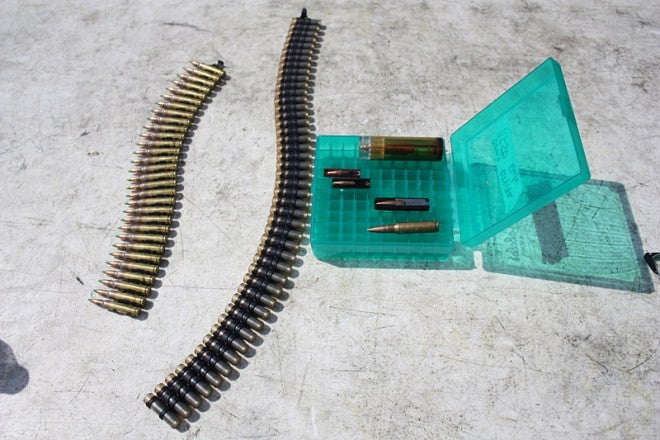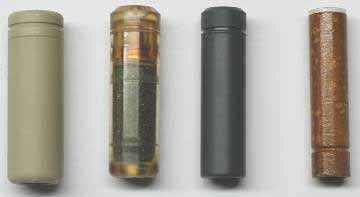The Joint Service Small Arms Program (JSSAP), which includes the program formerly called Lightweight Small Arms Technologies (LSAT) has unveiled a new scaled-up 7.62mm machine gun that fires a larger variant of that program’s cylindrical plastic-cased 7.62mm ammunition. Military.com’s KitUp! reports:
TAMPA, Fla. — Textron Systems showed off its newest effort to develop an ultra-light 7.62mm machine gun at the 2015 Special Operations Forces Industry Conference.
The new MG is being designed to weigh 14.5 pounds – more than eight pounds lighter than the lightest version of the M240.
The effort is part of the Case-Telescoped Weapons and Ammunition program which has produced a matured 5.56mm lightweight machine gun similar to the M249 squad automatic weapon, according to Textron officials.
The newer 7.62mm version is under contract with Joint Service Small Arms Program Office to develop the operating system to handle the larger caliber, according to Ben Cole, mechanical engineer for AAI Corp., owned by Textron. JSSAP is based in the U.S. Army’s Armament Research, Development and Engineering Center at Picatinny Arsenal, N.J.
Formerly known as the Army’s Lightweight Small Arms Technologies, or LSAT, the program is designed to lower ammunition weight by 40 percent as well as producing significantly lighter infantry weapons.
The result would be a 14.5-pound 7.62mm case-telescoped machine gun, compared to the Army’s M240B machine gun which weighs 27 pounds. The new, lightweight version — the M240L — weighs about 22 pounds.
The overall effort has already produced a 5.56mm CT weapon that weighs 9.4 pounds, compared to the M249 SAW, weighing in at approximately 17 pounds.
Military testers have fired about 85,000 5.56mm CT rounds through 10 test guns, said Cole, adding that the weapon has gone as far as it can go until the Army decides if it wants to make it a program of record.
A firing prototype of the 7.62mm CT weapon is expected to be ready by the fall of 2016, Cole said.
US military programs are notorious for taking a long time to complete, and small arms programs in this country tend also to be underfunded. It’s no surprise then, that the 7.62mm plastic-cased machine gun firing prototype is expected no earlier than late 2016.
Initially, the LSAT program’s plastic-cased ammunition began as a telescoped type, with the projectile buried within the propellant. Theoretically, this reduces the size of the ammunition, and allows a neat, cylindrical form factor that However, as this mid-1990s report from Inspector General’s Office notes, telescoped ammunition is not without its drawbacks:
Cased telescoped cartridge designs are larger in diameter than conventional cartridges, thus providing a larger volume for propellant. Therefore, in the programs reviewed, typical cased telescoped ammunition contained two to three times the weight of propellant charge compared to the baseline conventional ammunition for a given caliber. Table 1-1 shows the conventional and cased telescoped ammunition data obtained from the Services.
Table 1-1 indicates that the higher muzzle velocity achieved by cased telescoped ammunition as compared to conventional ammunition is a function of higher propellant charge weight. A comparison of the muzzle velocity between conventional ammunition and cased telescoped ammunition with respect to projectile weight and propellant charge weight indicates that cased telescoped ammunition is less ballistically efficient than conventional ammunition. For a given caliber, a cased telescoped cartridge weighs more and occupies more volume than a conventional cartridge of the same caliber. As a result of the higher propellant loads in cased telescoped ammunition, a significantly higher temperature and heat input is imparted to the gun barrel and barrel life is significantly reduced.
The additional bulk of ammunition mentioned in the report is evident in one of the early LSAT Spiral 1 5.56mm ammunition prototypes, shown at left in the picture below:
This early ammunition used standard propellant, and was approximately the same diameter as a brass-cased 7.62mm NATO round, costing a significant amount of bulk versus conventional brass-cased 5.56mm ammunition. The LSAT team further improved the ammunition by using improved propellants, but eventually the telescoped ammunition concept was apparently quietly dropped, as the latest 7.62mm plastic-cased prototypes show propellant not fully encasing the projectile in the case, which remains cylindrical and externally similar to earlier ammunition:

Some LSAT ammunition, from a 2011 shoot. Note the 7.62mm concept round, laying on the ammunition box, and that its propellant chamber does not extend past the cannelure of the bullet. Image source: kitup.military.com
While this alleviates issues of barrel wear, and allows a much more efficient use of the propellant (and thus much less of it), LSAT machine gun prototypes appear to still be chambered for Spiral 2 or 3 ammunition, also visible belted in the above photo.
Beyond the issues surrounding telescoped ammunition, the moving chamber mechanism also invites problems of flame-cutting, similar to those experienced by revolvers. LSAT machine guns have to deal with this issue somehow, as they are (unlike revolvers) fully enclosed, and fully automatic. It’s my suspicion, therefore, that while propellant and material technologies pioneered in the LSAT/JSSAP program will be incorporated into future ammunition, the LSAT ammunition configuration itself and the mechanism used by the LSAT machine guns will likely both be dead ends.
 Your Privacy Choices
Your Privacy Choices




